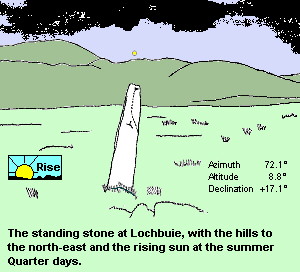
Lochbuie, Mull - standing stone
Stones
of Wonder
QUICK LINKS ...
HOME PAGE
INTRODUCTION
WATCHING
THE SUN, MOON AND STARS
THE
MONUMENTS
THE
PEOPLE AND THE SKY
BACKGROUND
ARCHAEOASTRONOMY
USING
THE SITE DESCRIPTION PAGES
VISITING
THE SITES
THE
LEY LINE MYSTERY
THE
SITES
ARGYLL
AND ARRAN
MID
AND SOUTH SCOTLAND
NORTH
AND NORTH-EAST SCOTLAND
WESTERN
ISLES AND MULL
Data
DATES
OF EQUINOXES AND SOLSTICES, 1997 to 2030 AD
DATES
OF MIDSUMMER AND MIDWINTER FULL MOONS, 1997 to 2030 AD
POSTSCRIPT
Individual
Site References
Bibliography
Links
to other relevant pages
Contact
me at : rpollock456@gmail.com
Standing Stone NM617255*
How to find: Follow the A849 south from Craignure for 9km, then turn left onto the minor road which leads eventually to Lochbuie. Look out for the stone in a field on the left (south) after about 10 km. Park at the small road bridge.
Best time of year to visit: Summer Quarter days sunrise, early May and early August.
 This
is a single standing stone about 2 metres tall by 1.5 metres wide and
about 40cm thick. It stands in a very boggy field. It now leans towards
the south-east, but the ground is so wet it is miraculous it is standing
at all.
This
is a single standing stone about 2 metres tall by 1.5 metres wide and
about 40cm thick. It stands in a very boggy field. It now leans towards
the south-east, but the ground is so wet it is miraculous it is standing
at all.
It has been suggested that this is not an astronomical slab, but an ancient route marking stone which indicates the way north up Gleann a' Chaiginn Mhoir which leads to Glen Mor and the main route to the Ross of Mull1.
The stone was however surveyed and found to have a possible astronomical function. To the south-west the bearing of 252.1° with the horizon height of 6.0° on the shoulder of Beinn nan Gobhar gives a declination of -4.9°. This seems to have no astronomical significance.
The reverse line to the north-east
has an azimuth of 72.1°. The horizon height on the nearby ridge is
all of 8.8° which produces a declination of +17.1°, so the line
is close to the rising position of the sun at the two summer Quarter days.
The stone would then be a complement to the nearby Lochbuie circle and
one of its outliers which indicates the sun at the two winter Quarter
days.
See also the page about the nearby
Lochbuie circle.